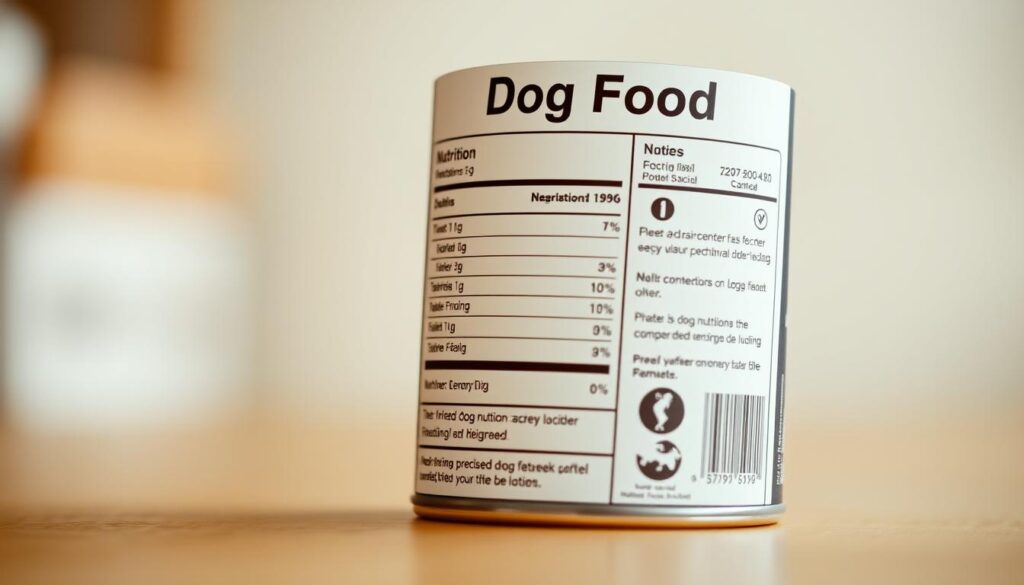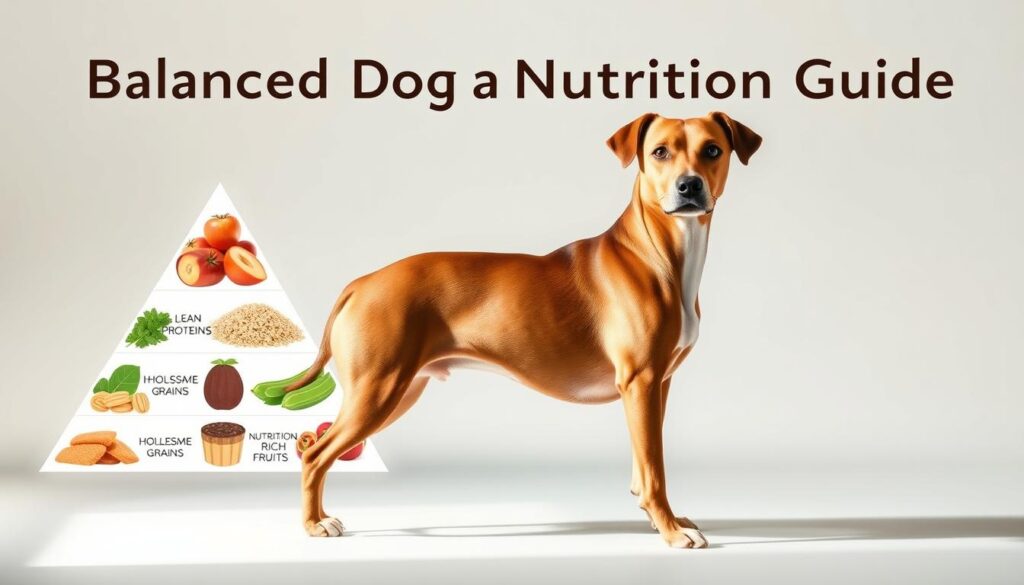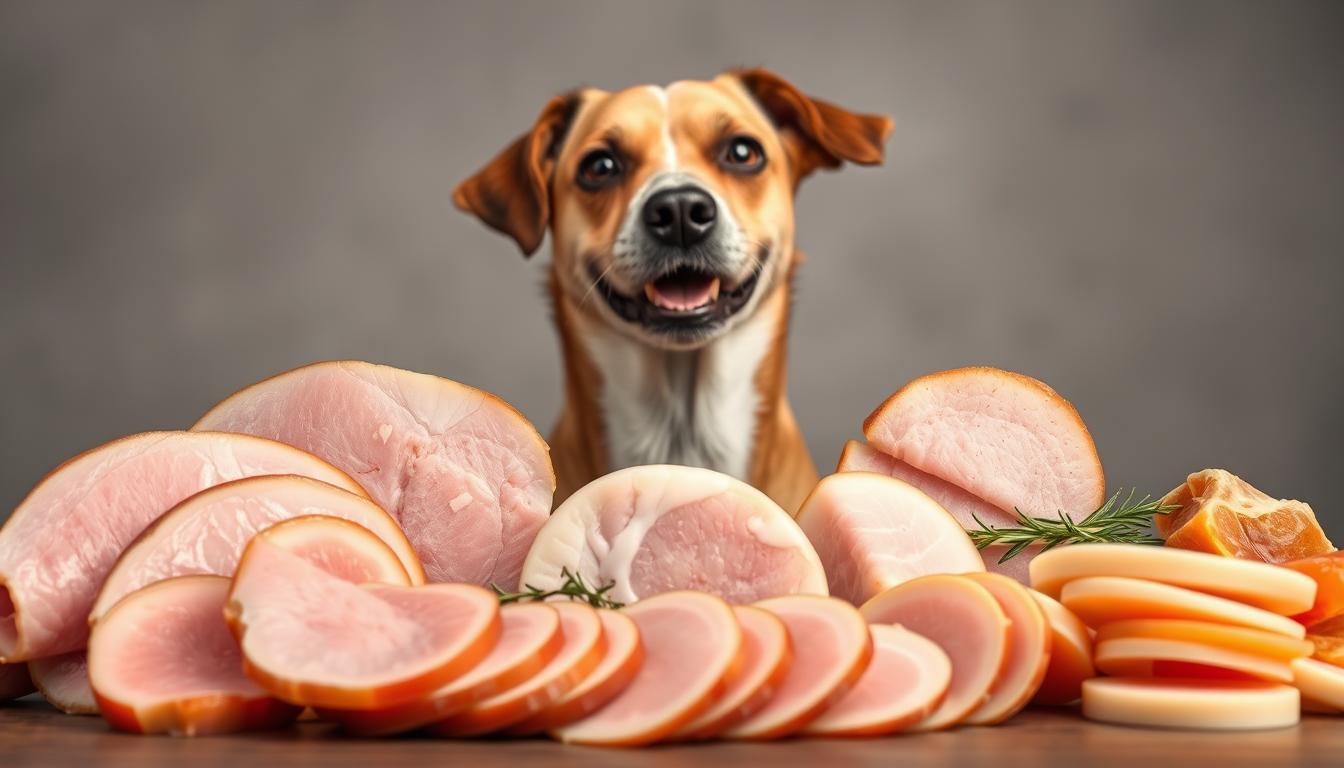Why Can’t Dogs Have Ham? 5 Important Safety Tips
Table of Contents
Why Can’t Dogs Have Ham?
As a dog owner, I learned that not all human foods are safe for our pets. One evening, while enjoying a holiday meal, my pup looked at a slice of ham with those irresistible puppy eyes. The urge to share was strong, but I decided to research why can’t dogs have ham.
It’s important to know the risks of feeding ham to dogs. While ham isn’t toxic, it’s not good for their health. It has too much sodium and fat, which can cause serious health problems. Every pet owner should be aware of this.
Dogs need different food than humans. The protein in ham might seem good, but there are better options. This guide will help you understand why ham is not a good choice for dogs.
Key Takeaways
- Ham is not toxic but can cause serious health issues for dogs
- High sodium content in ham can be dangerous for canine health
- Dogs require balanced protein sources different from human foods
- Occasional small amounts may not cause immediate harm
- Consult with a veterinarian about safe protein alternatives
Understanding Dogs’ Dietary Needs
Caring for your dog’s nutrition is important. Many wonder if dogs can eat deli ham. Knowing their dietary needs is key for their health.
Dogs need different nutrients than humans. Their diet must be balanced to keep them healthy. Ham can be harmful to dogs.
Nutritional Requirements for Dogs
A good dog diet includes essential nutrients. These support their growth, energy, and immune system. Important nutrients include:
- High-quality proteins
- Appropriate fat content
- Complex carbohydrates
- Vitamins and minerals
Common Dog Food Ingredients
Commercial dog foods meet nutritional standards. They often include:
| Ingredient Category | Purpose | Examples |
|---|---|---|
| Proteins | Muscle development | Chicken, beef, fish meal |
| Carbohydrates | Energy source | Rice, sweet potatoes |
| Fats | Energy and nutrient absorption | Chicken fat, fish oil |
The Role of Proteins and Fats
Proteins are vital for muscle health. Adult dogs need at least 18% protein. Fats give energy and help cells work well. But, ham’s high sodium is bad for dogs.
“Not all protein sources are created equal. Quality matters more than quantity.” – Veterinary Nutrition Expert
Thinking about deli ham for dogs? There are safer protein options that won’t harm them.
The Risks of Feeding Ham to Dogs
Feeding ham to your dog might seem like a tasty treat. But, it can lead to serious health complications. It’s important to understand the risks to keep your furry friend healthy.
The sodium in ham is a big health risk for dogs. Dogs can’t handle as much sodium as humans. Eating too much salt can cause many health problems.
High Sodium Content and Its Effects
Ham has very high sodium levels. This can cause serious health issues in dogs. Some problems include:
- Dehydration
- Increased blood pressure
- Kidney strain
- Potential sodium poisoning
Potential for Pancreatitis
Ham can also lead to pancreatitis in dogs. The fat in ham can cause inflammation of the pancreas. This is a painful and serious condition.
- Severe abdominal pain
- Vomiting
- Loss of appetite
- Lethargy
Risk of Obesity and Weight Gain
Eating ham can cause unhealthy weight gain in dogs. Ham is high in fat and sodium. This makes it a calorie-dense food that can lead to obesity.
| Food Type | Sodium Content | Fat Percentage |
|---|---|---|
| Processed Ham | 800-1000 mg per 100g | 15-20% |
| Lean Protein Alternative | 50-100 mg per 100g | 3-5% |
To protect your dog’s health, make smart food choices. Avoid ham and choose safer protein options. This can help prevent health problems.
The Types of Ham That Are Commonly Available
Understanding the different types of ham is key when thinking about your dog’s diet. Not all hams are safe for dogs. They can cause digestive problems because of their high sodium and fat.
- Processed Ham: Packed with preservatives and excessive salt
- Fresh Ham: Still too fatty for dog consumption
- Cured Ham: High in sodium and potential additives
- Honey-Baked Ham: Dangerous due to added sugars
Processed Ham: Understanding the Risks
Processed ham has many ingredients that can upset a dog’s stomach. It’s high in sodium and has chemical preservatives. Vets say it’s best to avoid processed meats for dogs.
Fresh vs. Cured Ham: A Nutritional Comparison
Fresh ham might seem better, but it’s still too fatty for dogs. Cured ham is even worse because of its salt and nitrates. Neither is good for your dog’s diet.
Honey-Baked and Glazed Hams: A Definite No
Honey-baked hams are very bad for dogs. They have sugars, glazes, and too much salt. Even a small piece can harm your dog’s health over time.
Signs That Your Dog Might Be Sick
It’s important for pet owners to know about health risks from high fat meat. Eating processed meat can cause serious problems that need quick help.
Dogs might show signs after eating the wrong foods, like ham. Spotting these signs early can stop bigger health problems.
Symptoms of Sodium Poisoning
Sodium poisoning can show in many ways:
- Excessive thirst
- Frequent urination
- Vomiting
- Diarrhea
- Muscle tremors
- Seizures
Recognizing Pancreatitis Signs
Pancreatitis from high-fat meats can hurt dogs a lot. Look out for these important signs:
- Hunched posture
- Abdominal pain
- Loss of appetite
- Repeated vomiting
- Lethargy
When to Contact Your Veterinarian
Your dog’s health is very important. Get vet help right away if you see:
- Persistent vomiting or diarrhea
- Significant behavioral changes
- Signs of extreme distress
- Continuous weakness or unresponsiveness
Trust your instincts. If you’re unsure about your pet’s health, getting professional advice can save their life.
Safe Alternatives to Ham for Dogs
Wondering why dogs can’t have ham? It’s key to find safe meat options for them. These should be nutritious and not harm their health.
Choosing the right proteins is vital for your dog’s diet. Safe alternatives are nutritious and avoid the risks of processed meats like ham.
Cooked Chicken: A Protein-Packed Option
Chicken is a top protein choice for dogs. Here’s how to prepare it safely:
- Always cook chicken thoroughly
- Remove all bones completely
- Serve plain, without seasonings or oils
- Cut into small, manageable pieces
Lean Turkey: Nutritional Powerhouse
Lean turkey is another great meat option for dogs. It’s low in fat and high in protein, perfect for dogs watching their weight.
“Quality protein sources are essential for maintaining your dog’s muscle health and energy levels.” – Veterinary Nutrition Experts
Raw Veggies: Healthy Snack Complement
Raw veggies are not meat but add important nutrients to your dog’s diet. Here are some safe options:
- Carrots
- Green beans
- Cucumber slices
- Pumpkin
Introduce safe meat alternatives slowly and in small amounts. Always talk to your vet to ensure the best diet for your dog.
Understanding Dog Food Labels
Reading dog food labels can be tough for pet owners. Many commercial dog foods contain processed meats that are harmful to pets. It’s important to know what you’re feeding your furry friend. The ingredients list helps you understand the food’s nutritional value and potential risks.

- Ingredient order and percentages
- Nutritional value claims
- Potential harmful additives
- Protein and fat content
Reading Ingredient Lists
High fat meat can be bad for dogs. Choose foods where real meat is the first ingredient. Stay away from foods with “meat by-products” or too many fillers.
| Label Indicator | What to Look For | Red Flags |
|---|---|---|
| Protein Source | Named meat (chicken, beef) | Unnamed meat sources |
| Fat Content | Balanced, moderate levels | Excessive animal fats |
| Preservatives | Natural preservatives | Chemical preservatives |
Understanding Nutritional Value Claims
Not all marketing claims are the same. Complete and balanced means the food meets basic nutritional needs. Be cautious of buzzwords and always check the ingredients.
Identifying Harmful Additives
Be careful of artificial colors, unnecessary fillers, and chemical preservatives. These can harm your dog’s health over time. Choose natural, whole-food ingredients that are good for your pet’s nutrition.
“Knowledge is the best ingredient in your dog’s diet” – Veterinary Nutrition Experts
How to Introduce New Foods to Your Dog
Changing your dog’s diet needs careful planning and patience. Dogs might have tummy troubles with new foods like ham. So, it’s key to introduce foods slowly and safely.
When looking for safe meat options for dogs, a step-by-step approach is best. This helps avoid upset stomachs and allergies.
The 3-Day Rule for Food Introduction
The 3-day rule is a good way to introduce new foods:
- Day 1: Start with a small amount (10% of their usual meal)
- Day 2: Keep an eye out for any bad reactions
- Day 3: If all is well, you can increase the amount
Monitoring for Allergies
Be on the lookout for signs of allergies when trying new proteins:
| Symptom | Potential Indication |
|---|---|
| Excessive itching | Potential food allergy |
| Digestive upset | Protein intolerance |
| Skin rashes | Immune response |
Gradual Changes in Diet
Slowly changing your dog’s diet helps avoid stomach problems. Mix new foods with their usual meals. Gradually add more of the new food over 7-10 days.
Talk to your vet before big diet changes. They can make sure the new food is right for your dog. They can also help with any digestive issues with ham or other proteins.
What to Do If Your Dog Eats Ham
Discovering that your dog has eaten ham can be stressful. While is ham toxic to dogs depends on various factors, knowing the right steps can help keep your pet safe. Dogs may accidentally consume ham, which requires immediate and careful attention.
When your dog has eaten ham, quick action is crucial. Not all instances of ham consumption are emergencies, but some require close monitoring.
Initial Steps to Take
- Remove any remaining ham from your dog’s reach
- Check the quantity of ham consumed
- Note the type of ham (processed or fresh)
- Assess whether the ham was seasoned
Monitoring Symptoms and Behavior
Can dogs eat deli ham without consequences? Not always. Watch for these potential warning signs:
| Symptom | Potential Concern | Action |
|---|---|---|
| Vomiting | Digestive Upset | Contact Veterinarian |
| Diarrhea | Sodium Overload | Hydrate and Monitor |
| Lethargy | Possible Pancreatitis | Immediate Vet Consultation |
Consulting Your Veterinarian
Professional guidance is essential when your dog experiences unusual symptoms after eating ham. Your veterinarian can provide personalized advice based on your dog’s specific health condition and the amount of ham consumed.
Remember, prevention is always better than treatment. Keeping ham and other potentially harmful foods out of your dog’s reach is the best approach to maintaining their health.
The Importance of a Balanced Diet
It’s key to give your dog a diet that’s full of nutrients. Knowing why foods like ham are bad helps you pick better for your pet.

Dogs need a diet that’s just right for them. Ham’s high sodium is a big no-no for your pet.
What Makes Up a Balanced Dog Diet?
A good dog diet should have:
- High-quality protein sources
- Essential fatty acids
- Vitamins and minerals
- Appropriate carbohydrates
Recommended Daily Nutritional Intake
Why can’t dogs have ham? It’s because of their nutritional needs. Adult dogs need:
- 18-25% protein
- 5-8% fat
- Less than 0.08% sodium
The Role of Supplements
Even with a balanced diet, some dogs might need extra help. Consult your veterinarian to see if your dog needs supplements.
Nutrition is the foundation of your dog’s health – choose wisely!
Myths About Feeding Dogs Human Food
Dog owners often wonder what human foods are safe for their pets. Many myths exist about giving dogs human food, especially meat like ham. Knowing the truth helps you make better choices for your pet’s nutrition.
Common Misconceptions About Ham
Ham is a tempting treat for many dog owners. But, ham can be harmful to dogs. It has too much salt and is processed, making it risky. Dogs digest food differently than humans, so what’s safe for us might not be for them.
- Ham is extremely high in salt
- Processed meats contain harmful preservatives
- Fatty meats can cause pancreatitis
Safe Foods vs. Unsafe Foods
It’s important to know which human foods are safe for dogs. Not all foods are bad, but many can harm their health.
| Safe Proteins | Unsafe Proteins |
|---|---|
| Cooked chicken | Processed ham |
| Lean turkey | Bacon |
| Boiled fish | Sausages |
Educating Yourself on Dog Nutrition
Being a responsible pet owner means always learning about your dog’s diet. Talk to vets, read good pet nutrition sources, and know what your dog needs. This keeps them healthy.
Remember: When in doubt, always choose specialized dog food and treats over human food.
When to Consult with Your Veterinarian
Caring for your dog’s health is more than just feeding and exercise. Veterinary visits are key in preventing and managing health issues. This includes digestive problems with ham and other diet concerns.
Regular vet visits are vital for your dog’s health. They help vets check your pet’s diet and spot risks from ham and pancreatitis.
Signs That Require Immediate Veterinary Attention
Some signs mean you need to see a vet right away. These include:
- Persistent vomiting or diarrhea
- Sudden changes in appetite
- Unusual lethargy or weakness
- Abdominal pain or swelling
- Difficulty breathing
Importance of Individualized Nutrition Advice
Every dog needs a diet that fits their unique needs. A vet can give personalized guidance based on your dog’s age, breed, and health. This is especially true for foods like ham.
Professional Guidance for Dietary Concerns
If your dog eats ham or has digestive issues, get vet advice fast. Vets can stop serious problems like pancreatitis. They offer treatments that fit your dog’s needs.
“Prevention is always better than cure when it comes to your dog’s health.” – Veterinary Nutrition Expert
Conclusion: Keeping Your Dog Healthy and Safe
Knowing why dogs can’t have ham is key for pet owners. High fat in meat can harm dogs a lot. What your dog eats affects their health, how long they live, and their happiness.
Choosing the right food for your dog is important. Ham might look good, but it’s bad for them because of its fat and salt. Vets say to avoid processed meats and stick to dog food that’s good for them.
Learning about dog food shows you really care about your pet. By picking lean proteins and the right amounts, and taking them to the vet often, you can keep them healthy. Every meal is a chance to make your pet strong and healthy.
Making Informed Food Choices
Choosing the right food means knowing what your dog needs. Talk to vets and do your research to make the best choices for your dog’s diet.
The Benefits of Understanding Dog Nutrition
Knowing about dog food can stop health problems and keep them in top shape. Your effort to learn about feeding will make your dog healthier.
Ensuring Your Dog’s Long-Term Health
Managing your dog’s diet is crucial to avoid health issues. By staying informed about their food needs, you’ll help your dog live a long, happy life.
FAQ
Is ham toxic to dogs?
Ham is not toxic right away, but it’s not good for dogs. It has too much salt and fat. Eating it often can harm your dog, causing pancreatitis, obesity, and sodium poisoning.
Why can’t dogs eat ham?
Dogs can’t eat ham because it’s too salty and fatty. It also has bad additives. These can upset their stomachs, cause pancreatitis, and lead to serious health issues.
What happens if a dog eats ham?
Eating ham can upset a dog’s stomach, causing vomiting or diarrhea. It can also lead to pancreatitis, sodium imbalances, and weight gain. These are serious health problems.
Are there safe meat alternatives for dogs?
Yes, dogs can eat lean meats like cooked chicken, turkey, and lean beef. Make sure they’re plain and without added oils or spices. Always check with your vet for the best food for your dog.
How much sodium is too much for dogs?
Dogs can’t handle much sodium. Too much can cause salt poisoning, with symptoms like vomiting and tremors. Commercial dog foods are made to keep sodium levels safe for pets.
Can dogs eat deli ham?
No, dogs should not eat deli ham. It’s too salty and has bad additives. These can upset their stomachs, cause pancreatitis, and lead to health problems.
What are the signs of pancreatitis in dogs?
Signs of pancreatitis include loss of appetite and vomiting. Dogs may also have abdominal pain and be lethargic. If you see these signs, especially after eating fatty foods, call your vet right away.
How can I safely introduce new foods to my dog?
Start with small amounts of new foods and watch for reactions. If your dog has vomiting or diarrhea, stop. Always talk to your vet before changing your dog’s diet.
There are no reviews yet. Be the first one to write one.


